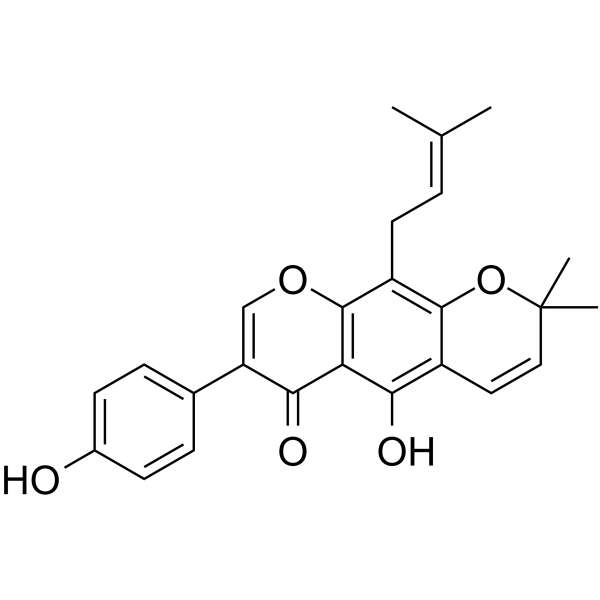天然产物 黄酮类 Flavonoids
Warangalone (Synonyms: 攀登鱼藤异黄酮; Scandenolone) 纯度: ≥98.0%
Warangalone 是抗疟疾化合物,能够抑制 3D7 (氯喹敏感) 和 K1 (氯喹耐药) 寄生虫的生长, IC50 值分别为 4.8 μg/mL 和 3.7 μg/mL。 Warangalone 还可以抑制环 AMP 依赖性蛋白激酶催化亚基 (cAK),其 IC50 值为 3.5 μM。

Warangalone Chemical Structure
CAS No. : 4449-55-2
| 规格 | 价格 | 是否有货 | 数量 |
|---|---|---|---|
| 1 mg | ¥3341 | In-stock | |
| 5 mg | 询价 | ||
| 10 mg | 询价 |
* Please select Quantity before adding items.
| 生物活性 |
Warangalone is an anti-malarial compound which can inhibit the growth of both strains of parasite 3D7 (chloroquine sensitive) and K1 (chloroquine resistant) with IC50s of 4.8 μg/mL and 3.7 μg/mL, respectively. Warangalone can also inhibit cyclic AMP-dependent protein kinase catalytic subunit (cAK) with an IC50 of 3.5 μM. |
IC50 & Target |
IC50: 4.8 μg/mL (3D7), 3.7 μg/mL (K1)[1] |
||||||||||
|---|---|---|---|---|---|---|---|---|---|---|---|---|---|
| 体外研究 (In Vitro) |
Warangalone is an anti-malarial compound which can inhibit the growth of both strains of parasite 3D7 (chloroquine sensitive) and K1 (chloroquine resistant) with IC50s of 4.8 μg/mL and 3.7 μg/mL, respectively[1]. Warangalone can also inhibit cyclic AMP-dependent protein kinase catalytic subunit (cAK) with an IC50 of 3.5 μM[2]. When HL-60 cells are exposed to Warangalone (30 μM) for 24 h, Warangalone induces a significant decrease (8%) in cell viability compare to controls. Warangalone also inhibits HL-60 cell growth within 24 h in a time-dependent fashion. A time-dependent increase in caspase-9 activity is observed in Warangalone-treated cells[3]. Shanghai Jinpan Biotech Co Ltd has not independently confirmed the accuracy of these methods. They are for reference only. |
||||||||||||
| 分子量 |
404.46 |
||||||||||||
| Formula |
C25H24O5 |
||||||||||||
| CAS 号 |
4449-55-2 |
||||||||||||
| 中文名称 |
攀登鱼藤异黄酮 |
||||||||||||
| 运输条件 |
Room temperature in continental US; may vary elsewhere. |
||||||||||||
| 储存方式 |
|
||||||||||||
| 参考文献 |
|
| Kinase Assay [3] |
The enzyme activities of caspase-3 and caspase-9 are measured using a caspase fluorometric assay kit. Cells are seeded in 24-well plates at a density of 3×106 cells per well. After exposure of the cells to Warangalone for the allotted time periods, the cells are washed three times with PBS, and then lysed in a lysis buffer for 10 min on ice. The protein content of the cell lysates is assayed with a Micro BCA reagent. Cell lysates containing 50 μg of protein are incubated with a caspase-3 fluorogenic substrate (DEVD-AFC) or a caspase-9 fluorogenic substrate (LEHD-AFC) for 1 h at 37°C. Caspase activity is measured by fluorometric detection[3]. Shanghai Jinpan Biotech Co Ltd has not independently confirmed the accuracy of these methods. They are for reference only. |
|---|---|
| Cell Assay [3] |
Cell viability is determined using the Cell Titer 96 Aqueous assay kit. Cells are seeded in 96-well plates at a density of 1×105 cells per well. The cells are maintained for 24 h at 37°C and then Warangalone (30 μM) is added to the culture medium. MTS solution is added to the 96-well plates at the indicated time points, and the cells are incubated for 1 h at 37°C. The absorbance is measured at a wavelength of 490 nm with a microplate counter[3]. Shanghai Jinpan Biotech Co Ltd has not independently confirmed the accuracy of these methods. They are for reference only. |
| 参考文献 |
|
